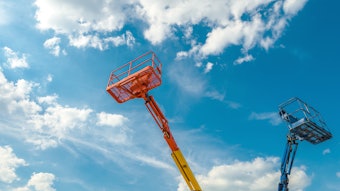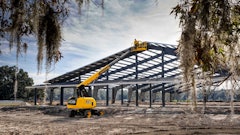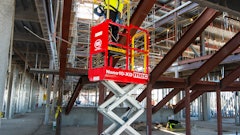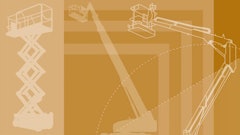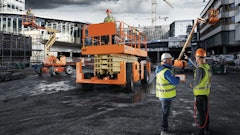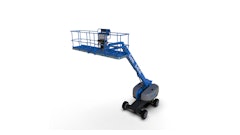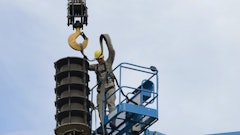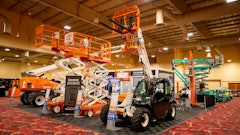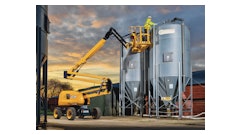
Genie lifts work their magic at Coachella Music & Arts Festival
Holding a rock concert for 60,000 people in the middle of the desert takes a lot of equipment. The Coachella Music and Arts Festival is held on the Empire Polo Grounds near Palm Springs and this year featured artists such as Coldplay and Nine Inch Nails.
The hot and dusty environment is a test of endurance for both the people creating this temporary city in the desert and the equipment used to make the festival possible. Genie Industries’ stick and articulating boom lifts were used by the producers of the festival for everything from tent building to transporting materials.
The Coachella Festival features five stages. Two huge outdoor stages are used for some of the most well-known artists, while the other three stages are housed in large tent structures.
Genie boom lifts are used in the construction of the tents — first to assemble the tent framework and then to help with the covering. The tents are constructed by assembling arch-shaped support beams on the ground. These beams are then erected one at a time and attached to each other to form the tents’ super structure.
The Coachella production staff that use Genie lifts go through a training program and are then given additional practice time operating each lift. The lifts are used during the festival in public areas, so each operator has to feel comfortable using the equipment. The lifts travel along the perimeter road at Coachella both during the building periods and during the festival. This road is also used by pedestrians, a tram, vendor’s vehicles and a significant number of golf carts; therefore, safety is a prime concern.
Once all the stages are erected, the lifts play a major role in allowing lighting, sound and projection crews to access equipment overhead. At the two largest stages, articulating boom lifts allow technicians to access lights that are directly over the stage from a lift positioned in the front row.
The articulation of the boom is such that the technicians can reach the entire area above the stage without disturbing the stage set below. Inside the tents, Genie lifts provide the only access to the trussing from which lights and speakers are hung. The large all-terrain tires on each lift easily navigate the turf of the polo field.
The Genie lifts that are used at the Coachella Festival, quite simply, allow access where otherwise there would be none. An entire infrastructure is created for the Coachella Festival, but Genie Industries’ stick and articulating boom lifts are used in place of the normal access infrastructure that would be found in a concert venue. The flexible nature of each lift, and its ease of use, means that they have a permanent home in the middle of the desert.
Local university finds versatility in Snorkel jib machines
At a local university in St. Joseph, MO, one of Snorkel’s new jib booms helps bring the university’s MIAA Football team many victories. The TB47J is used at all the university’s home games and practices to film the team from a higher level. On a higher plane, the team is able to study their plays and improve on their techniques.
When this machine isn’t participating with the football team, the university has been able to use this machine in a variety of applications. For example, they use the Snorkel TB47J to maintain the lighting around the football field and in keeping up the football arena.
They also use the jib boom to preserve and repair their clock tower in the center of campus, as well as general maintenance and upkeep on all of the other campus buildings. The university maintenance staff likes Snorkel’s booms the best because of the ease of use and versatility the jib gives them. They are able to use the machine all over the campus and in hard-to-reach places.
Snorkel offers a wide range of products including jib booms that range from 42 to 126 feet, articulating booms from 41 to 60 feet, and straight booms from 42 through 120 feet. Other products in the line include trailer-mounted lifts.
JLG’s SkyPower lights up rental company
One of the businesses affected during Hurricane Rita last fall was an equipment rental location in Houston, TX. Although the location wasn’t hit by the storm, wind damage from downed trees in the area shut down power to their shop. Without power, the mechanics were unable to perform their normal service duties.
Usually this would not have been a problem for them since generators are among their most popular rental items. But because of the huge demand for generators prior to the hurricane reaching land, the location had rented out most of their inventory. This left them without sufficient means to provide the necessary emergency power to the shop.
That’s when one of the mechanics had an idea — why not use the on-board generators in the JLG 600S boom lifts that they had in their yard to provide the power?
The SkyPower generator produces 7,500 watts (10,500-watt peak) and is part of the Workstation in the Sky package that is incorporated as a standard feature into many JLG models.
So they started up a JLG 600S boom lift, drove it over to a service bay door and plugged extension chords into the AC outlet mounted on the platform. It was just what they needed. The SkyPower generator produced enough electricity to power lights, shop tools and a large fan. The shop was in business.
The SkyPower generators worked so well they positioned JLG machines in front of several service bays and used the power outlets in the platform to keep the shop running for almost three days. It gave new meaning to JLG’s slogan, “The Power to do More.”
Mud is no match for JLG crawler-mounted booms
Boston’s “Big Dig” was the popular name for the eight-mile underground arterial project connecting Logan Airport with the city.
When it was underway, one of the problems contractors faced was the terrain. The area where the highway was routed consisted of ocean muck that had been used as fill when Boston was founded 365 years ago. Overall, the job entailed dredging out muck from a trench, then installing overhead beams to provide above-ground support.
Aerial work platforms were the only practical way to install struts and walers on steel pilings that were 20 to 30 feet overhead. While boom lifts were able to lift workers to where they were bolting cross members, conventional four-wheel drive units were an ongoing headache for the project managers.
The solution to traversing the reclaimed ocean floor was found with JLG crawler-mounted boom lifts. From the moment they were introduced to workers, the machines were adopted as the solution for overhead access on a surface that was even too mucky and soft for workers to walk across.
JLG offers the crawler-mounted boom lifts in three configurations and with tracks that can counter rotate, i.e. one track moves forward while the other moves backward so the machines turn around their midpoint for a true zero turning radius.
Another example of dealing with mud on a jobsite occurred in Shreveport, LA where JLG Model 600SC crawler-mounted boom lifts with a straight boom and 60-foot platform height were used to help workers erect the steel frame for a portion of a General Motors light-duty truck assembly plant.
Heavy rains had fallen in late November when SCI/Steelcon started the job. “Once the rains stopped, we were left with mud over two feet deep in many areas, so there was just no way we could drive a machine with tires around the site without getting stuck,” recalls Jeremy Hughes, site safety manager. “Since most of the work was overhead, we needed aerial work platforms and the only way we could get them into working position was to move them with a dozer or something similar. It was a time-consuming task that could take 30 minutes just to get the machine set up and leveled so it could be safely operated.”
Crawler machines were rented to replace the tired units SCI/Steelcon had planned on using. Even with mud that was so deep in some places that it completely covered the tracks, the JLG crawler machines were able to navigate without a problem.
The 20-inch-wide steel-link tracks gave them a much larger footprint than rubber-wheeled machines and provided better weight distribution with lower ground pressure. The 60-foot platform height machines that SCI/Steelcon used have 5.45-psi ground pressure compared to 67 psi for comparable JLG wheel-mounted boom lifts. Gradability on the crawlers is rated at 55 percent versus 45 percent for similar four-wheel drive machines. Steel tracks are the usual configuration, but rubber padded tracks are available as an option.
When crews at SCI/Steelcon found that the JLG crawler units could be moved, setup and positioned in about three to four minutes versus the 30 minutes for the wheel units, a total of eight machines were put on the job. Not only was time saved getting personnel to their work, SCI/Steelcon didn’t have to tie up another piece of equipment and an operator.
As Mark Mohn, JLG boom lift product champion says, “With their enhanced maneuverability, low ground pressure and superior traction, crawler-mounted boom lifts are frequently the only equipment that can be used on a job. Regardless of whether you are a big rental user like SCI/Steelcon or a single-machine owner, when you have overhead work, a crawler-mounted boom lift can be your best option.”





